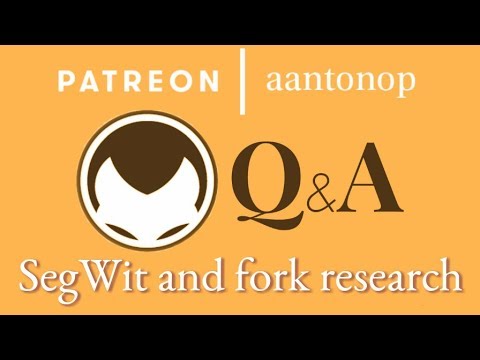How likely is a hard fork to increase the block size in the future? Under what conditions might that happen? What is being prioritised in the roadmap? Why implement Segregated Witness (SegWit) instead of “simply” increasing the block size limit?
More on SegWit and capacity increase research: https://bitcoincore.org/en/2015/12/23/capacity-increases-faq/
More on Bitcoin hard fork research: https://bitcoinhardforkresearch.github.io/
These questions are from the February Patreon live Q&A and MOOC session 9.5, which took place on February 24th and March 16th 2018 respectively. Andreas is a teaching fellow with the University of Nicosia. The first course in their Master of Science in Digital Currency degree, DFIN-511: Introduction to Digital Currencies, is offered for free as an open enrollment MOOC course to anyone interested in learning about the fundamental principles.
If you want early-access to talks and a chance to participate in the monthly live Q&As with Andreas, become a patron: https://www.patreon.com/aantonop
RELATED:
What is a fork? – https://youtu.be/QwEDtdkV3Q4
What happens during a fork? – https://youtu.be/XBk8hBJ1xVo
Airdrop coins and privacy implications – https://youtu.be/JHRnqJJ0rhc
The dangers of hard forks in protocol evolution – https://youtu.be/vxEHRvhJKvA
Proof-of-work changes – https://youtu.be/AcaktuPdQrc
A voluntary alternative to mandatory currencies – https://youtu.be/5ogv3Eya9nQ
Consensus Algorithms, Blockchain Technology, and Bitcoin – https://youtu.be/fw3WkySh_Ho
Advanced Bitcoin Scripting Part 2: SegWit, Consensus, and Trustware – https://youtu.be/pQbeBduVQ4I
What is Consensus: Rules without Rulers – https://youtu.be/2tqo7PX5Pyc
Forkology: A Study of Forks for Newbies – https://youtu.be/rpeceXY1QBM
What is the roadmap? – https://youtu.be/5Eoj_sKyC90
Nonces, mining, and quantum computing – https://youtu.be/d4xXJh677J0
Cryptographic primitives – https://youtu.be/RIckQ6RBt5E
The rules of Bitcoin (part 1) – https://youtu.be/VnQu4uylfOs
The rules of Bitcoin (part 2) – https://youtu.be/vtIp0GP4w1E
Rules versus rulers – https://youtu.be/9EEluhC9SxE
Migrating to post-quantum cryptography – https://youtu.be/dkXKpMku5QY
Honest nodes and consensus – https://youtu.be/KAhY2ymI-tg
Scaling, trust, and trade-offs – https://youtu.be/vCxmHwqyJWU
What is the role of nodes? – https://youtu.be/fNk7nYxTOyQ
Why running a node is important – https://youtu.be/oX0Yrv-6jVs
Misconceptions about the Lightning Network – https://youtu.be/c4TjfaLgzj4
Lightning, full nodes, and miners – https://youtu.be/dlJG4OHdJzs
What is Segregated Witness? – https://youtu.be/dtOjjB4mD8k
SegWit adoption – https://youtu.be/KCsTVTRk6I4
MimbleWimble and Schnorr signatures – https://youtu.be/qloq75ekxv0
Atomic swaps – https://youtu.be/fNFBA2UmUmg
Andreas M. Antonopoulos is a technologist and serial entrepreneur who has become one of the most well-known and respected figures in bitcoin.
Follow on Twitter: @aantonop https://twitter.com/aantonop
Website: https://antonopoulos.com/
He is the author of two books: “Mastering Bitcoin,” published by O’Reilly Media and considered the best technical guide to bitcoin; “The Internet of Money,” a book about why bitcoin matters.
THE INTERNET OF MONEY, v1: https://www.amazon.co.uk/Internet-Money-collection-Andreas-Antonopoulos/dp/1537000454/ref=asap_bc?ie=UTF8
[NEW] THE INTERNET OF MONEY, v2: https://www.amazon.com/Internet-Money-Andreas-M-Antonopoulos/dp/194791006X/ref=asap_bc?ie=UTF8
MASTERING BITCOIN: https://www.amazon.co.uk/Mastering-Bitcoin-Unlocking-Digital-Cryptocurrencies/dp/1449374042
[NEW] MASTERING BITCOIN, 2nd Edition: https://www.amazon.com/Mastering-Bitcoin-Programming-Open-Blockchain/dp/1491954388
Subscribe to the channel to learn more about Bitcoin & open blockchains!
Music: “Unbounded” by Orfan (https://www.facebook.com/Orfan/)
Outro Graphics: Phneep (http://www.phneep.com/)
Outro Art: Rock Barcellos (http://www.rockincomics.com.br/)
source















Antonopoulos is a breath of fresh air!
Making many simple changes or one huge complicated change is not a balance. Many simple changes is always better.
So, BCH in the Lightning Network? BCH is the hardfork you’re talking about correct?
@aantonop What do you think about Self-sovereign identity systems like uPort?
thanks for ENG subtitle!!!
WTF I thought lightning was going to get it done
And I mean technically not methodology
Is Andreas saying ver was correct?
What a mess btc is.
So glad I've swapped to bitcoin cash.
It works great now.
Andreas knows so much about BTC that sometimes I suspect he might be the Satoshi Nakamoto 🙂
thanks for the great content, really good subtitles also. Thumbs up to whoever transcribed for you 😀
instead of block size how about coin fractioning the coin is already sold by bits on exchanges but the speed needs to increase
Hi Andreas, have you heard of holochain for scalability?
why would a hard fork be needed? cant you just increase the cap?
Can we have a "Bitcoin Space"-fork, which uses Proof-Of-Capacity for mining? i think this would benefit Harddisk-development and reduce energy consumption. it would be the first Altcoin i use beside Bitcoin. 🙂 how we do it?
Hi, Can you help me understand why Bitcoin leads market with itself, either up or down?
AA you are one of the reasons I got on board,
The benefits of Schnorr Signatures are unfortunately undermined by SegWit and would of had a bigger effect on scaling with a hard fork.
Any decrease in Witness size is at most 1/4 as effective for scaling the number of tx's.
take Anthony Towns example of anyone pays anyone p2pkh 800kB Base data and 800kB Witness data
Best case scenario – aggregate Witness into 1 Sig,
Under Segwit still only gives you ~25% increase in the number of txs
Now had we forked to 2MB with Schnorr Sigs the above scenario gives ~250% increase in number of txs
Sorry Andreas, the statement about LN vs Big Blocks that "it's about choice' is true only if you view Bitcoin as a science project with no time pressures, but not if you want solutions to horrible capacity problems that exist at the present moment.
In a situation where the immediate 'hair on fire" problem are high fees, long transaction times, and horrible user experience, how can anyone defend the decision to instead prioritize a malleability fix which as you say is for smart contracts?
How can this fix, with the complexity it adds, as well as the obligation on others in the ecosystem to do work to be compatible, be more important than discussing and working on an obvious parameter change that instantly provides a solution and that is also very likely to benefit any future off chain solution?
Having been, and also worked with developers all my life, I can attest to the fact that while developers are super smart at tech, outside academia, the most passionate ones are not to be trusted with the product roadmap of any project that has any kind of commercial requirement.
And maybe that's the problem, that one camp does not see Bitcoin as something that should be driven by commerial realities
And so the narrative changes again. I wonder what he'll do when he realizes there is a 0% chance btc will increase blocksize. Most everyone else has realized this already, hence why bch exists in the first place
you are crying?
Just as sensible people always knew, Blockstream always considered block size increase as an option. They weren't blind to that option like Bcash supporters usually claim.
Great video @aantonop. Is the hardfork inevitable and absolutely necessary in order for proper scalability?
I think Roger Ver is right….increasing the block size seems to working well for BCH …it's faster and less expensive …..
Smashed the like……
❤ what you do! Have you looked at BitcoinCore(BTCC) yet???
Large blocks are an invitation to angry ex-you tubers.
Video content makers might even forgo the mining reward to get 8 megs of upload….or even x4.
Like++;
first